At Albaro, a bucolic suburb of Genova or Genoa, Dickens began the not-so-grand portion of his Italian Grand tour. To begin with, despite the losses involved in prosecuting Peter Parley's Illuminated Library for pirating A Christmas Carol, Dickens's relatives — especially his father — regularly called upon the young writer for financial assistance. Moreover, having ground out so many full-length novels over the past eight years, Dickens must have been both exhausted and in need of emotional and artistic renewal. Finally, his latest serialisation, Martin Chuzzlewit, had been neither a critical nor a popular success; indeed, it had provoked a firestorm of controversy across the Atlantic over the satirisation of the American political and social scene, including the violence and coarseness of many of the rapacious American characters. Time for a change indeed.
But as Mr. Joseph Tuggs some years earlier had ruminated in "The Tuggses at Ramsgate," where might an Englishman of some means and his family go for a salubrious climate, inexpensive luxury, picturesque locale, and warm winters? The answer for the Whiggish Dickens, enthusiastic supporter of Lord John Russell, was the liberal state of Piedmont and the comfortable suburb of Albaro, on the Mediterranean shore. He and Catherine started taking lessons in Italian from Luigi Mariotti in January 1842 as they were going to America (Ackroyd, 425) aboard the Britannia. They took lessons twice a week from Mariotti in the months prior to their departure for Italy, but these apparently were insufficient preparation to understand (let alone to speak) the regional Italian dialect spoken in Genoa. Purchasing a huge carriage for 45 pounds, renting out Devonshire Terrace, and hiring a capable French courier (Louis Roche), Dickens, his four horses and their postilion, and his party of eleven (including his wife, Catherine, his sister-in-law, Georgina Hogarth, the five Dickens children, three servants and a nurse) set off, crossing the Channel on 2 June and arriving at Marseilles on the evening of Sunday, 14 July, 1844. From the French metropolis they made their way by boat to the port of Genoa, thereby avoiding the Alps altogether.
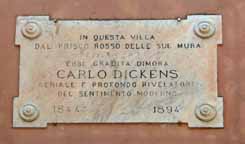
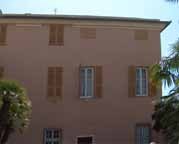
Left: The exterior of the "Pink Jail." Right: A commemorative plaque. [Click on the thumbnails for larger images.]
By the evening of Tuesday, 16 July, he and his family, their enormous carriage barely negotiating the narrow Albaro streets above the sea road, had installed themselves the Villa di Bagnerello (or Bagnarello, the name of the local owner), whose lease the Scottish sculptor and Genoa resident Angus Fletcher (an acquaintance from holidays at Broadstairs), had arranged — as Forster says, "at a rent absurdly above its value" (Vol. 1, p. 216). Perhaps punning on "bargello" and "Bagnerello," Dickens dubbed it "The Pink Jail." Owing to the palm tree out front, the upscale farmhouse was plagued by mosquitos — and there was no shortage of fleas, flies, scorpions, lizards, frogs, rats, beetles, and spiders.
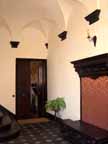

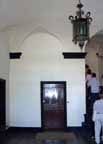
Three interior views of the Villa di Bella Vista
[Click on the thumbnails for larger images.]
But the house offered magnificent views of the Mediterranean, and Dickens pronounced the scenery "exquisite," and when it was not raining enjoyed the blue of the Mediterranean, which, he remarked to Forster, "surpasses all conception or description" (Vol. 1, p. 216). But for the intense heat of the African wind, the sirocco, Dickens enjoyed the location, with its breezes from the sea and winds from the mountains, and indulged himself in "sea bathing" with the children. While ocean swimming shortly after his arrival at Albaro in mid-September, Fred Dickens nearly drowned in the bay, the children on the shore mistakenly identify the victim as their father. The hapless Fred might have drowned in the strong current but for the providential intervention of some local fishermen whose boat had just left the harbour.
Peter Ackroyd, doubtless having visited the Bagnerello when researching Dickens (1990), describes this initial Italian residence which the Dickens family occupied for some ten weeks as "a large but not a grand house, surrounded by high walls but overlooking vineyards and the Bay of Genoa; the courtyard opened onto a small front hall, where a marble staircase led upwards to commodious and well proportioned rooms" (435). Forster mentions "lofty ceilings, icy floors, and lattice blinds" (216) — Dickens may have entertained the notion of moving as soon as he realized that the place would be difficult to heat in the coming winter. In addition to the noble entranceway, Dickens continued to Forster,
The lower storey (nearly concealed by the vines) consists of the hall, a wine-cellar, and some store-rooms. The three windows on the left of the first floor belong to the sala [i. e., the main apartment], lofty and whitewashed, which has two more windows round the corner. The fourth window did belong to the dining-room, but I have changed one of the nurseries for better air; and it now appertains to that branch of the establishment. The fifth and sixth, or two right-hand windows, sir, admit the light to the inimitable's (and uxor's) chamber; to which the first window round the right-hand corner, which you perceive in shadow [in Angus Fletcher's sketch], also belongs. The next window in shadow, young sir, is the bower of Miss H. [i. e., Georgina Hogarth]. The next, a nursery window; the same having two more round the corner again. The bowery-looking place stretching out upon the left of the house is the terrace, which opens out from a French window in the drawing-room on the same floor of which you see nothing, and forms one side of the court-yard. The upper windows belong to some of those uncounted chambers upstairs; the fourth one, longer than the rest, being in [Angus] Fletcher's bedroom. There is a kitchen or two up there besides, and my dressing-room; which you can't see from this point of view. The kitchens and other offices in use are down below, under that part of the house where the roof is longest. On your left, beyond the bay of Genoa, about two miles off, the Alps stretch out into the far horizon; on your right, at three or four miles distance, are mountains crowned with forts. The intervening space on both sides is dotted with villas, some green, some red, some yellow, some blue, some (and ours among the number) pink. At your back, as I have said, sir, is the ocean; with the slim Italian tower of the ruined church of St. John the Baptist rising up before it, on the top of a pile of savage rocks. You go through the court-yard, and out at the gate, and down a narrow lane to the sea. Note. The sala goes sheer up to the top of the house; the ceiling being conical, and the little bedrooms built round the spring of its arch. (218-219)
A little more information (not reflected directly in Pictures from Italy) about Dickens's perspective on Albaro and on the palazzo he had just arranged to lease inside the city proper may be gleaned from "To Count D'Orsay, 7 August 1844" (from Letters, Vol. 4, pp. 166-167)
Albaro, Near Genoa. Wednesday August Seventh 1844
Let me explain to you where I am. Do you recollect Byron's old house? [Tillotson's editorial note: The Villa Saluzzo at Albaro, situated on the hill of the Grand Paradise; Byron occupied the villa from the autumn of 1822 until his departure for Greece in July 1823. . . .] Yes? Well. It isn't that — as they always say on the stage, when the two comic men are sitting in chairs before the lamps — but keeping on, up the hill past Byron's house, you come to another large house at the corner of a lane, with a little tumble-down blackguard old green-grocer's shop at the other corner, on which is painted, if I recollect right, Croce di San Lorenzo. The Governor lives in the large house opposite the Green Grocer's now; and turning down between the Governor's and the Green Grocer's, you go down a long, straggling, very narrow lane until you come to mine: which is on the left hand, with the open Sea before it — a fort close by, on the left — a vineyard sloping down towards the shore — and an old ruined church dedicated to St. John the Baptist (which I dare say Lady Blessington will remember) blotting out just so much of the sea as its walls and tower can hide. It is properly called The Villa di Bella Vista; but I call it the Villa di Bagnerello — that being the name of an amiable but drunken butcher into whose hands it has fallen, and who, being universally known (in consequence of being carried home from some wine shop or other every night), is a famous address: which the dullest errandboy recognizes immediately.


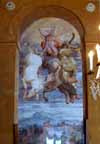
Three frescoes from the Dickens's second residence in Italy — The Palace of the Marchese Pallavicini (the Peschiere)
[Click on the thumbnails for larger images.]
There is a delicious air here — almost always a sea breeze — and very good bathing. The house is bare of furniture, but especially clean. The Sala is very large, and the bedrooms excellent. As it would never do for a winter residence, however, I have been looking about me, and have concluded an arrangement, I hope, for the Peschiere: entering on the possession of that Palazzo, on the first of October. I have the whole Palace except the Ground Piano. I don't know whether you ever saw the rooms. They are very splendid indeed; and every inch of the walls is painted in fresco. The Gardens also, are beautiful.
Tillotson's note on The Palace of the Marchese Pallavicini (the Peschiere)
The Palace of the Marchese Pallavicini, within the walls of Genoa; known as the Peschiere from the fishponds which were a feature of its gardens; built by the architect Galeazzo Alessi in about 1560. Guide books and travel-writers noted its position on the hill of S. Bartolomeo, commanding views over the sea and surrounding mountains, the beauty of the terraced gardens with their grottoes, flowering shrubs and orange and lemon trees, and the remarkable 16th-century frescoes by the Semini brothers which decorated the lofty rooms (see, for example, H. J. Bunnett, A Description Historical and Topographical of Genoa, 1844, p. 52, and Descrizione di Genova e del Genovesato, Genoa, 1846, III, 330-31).
The idea behind this Italian sojourn seems to have been to engage in physical, mental, and emotional renewal, saving money by living abroad and making the most of the time by undertaking two projects for Dickens's new publishers, Bradbury and Evans. The first, like American Notes for General Circulation, would record the writer's impressions of a foreign country that many English people had visited, the basis for the nonfiction "travelogue" being the frequent and detailed letters he wrote to Forster back in London. As a middle-class Liberal addressing a chiefly Liberal and middle-class readership, Dickens must have anticipated that he would say nothing terribly controversial that would mar sales — after all, he expected physical and social decay and political corruption and must have felt that such "pictures" would be agreeable to an English audience. The second project Dickens envisaged as a way of recouping his fortunes: a "second Christmas Carol" designed to appeal to that same market he had virtually created the year before and following the same narrative and pictorial formula — and hopefully achieving sales at least as great. The former project became Pictures from Italy, the latter The Chimes: A Goblin Story of Some Bells That Rang an Old Year Out and a New Year In. But what with the heat, rain, and relative isolation of the Bagnerello, somehow Dickens could not accomplish much at Albaro. A significant factor often overlooked by his biographers but mentioned recently by lineal descendant Lucinda Dickens-Hawksley was a severe illness that afflicted his favourite child, Katey, a painful swelling of the neck which may have been caused by her drinking copious quantities of unpasteurized milk produced by the two dairy cows that were housed in a cowshed in the garden of the Bagnerello. Fortunately, by the time it came to move to Genoa proper at the end of September, Katey had recovered, and Dickens, freed from the onerous responsibility of attending to the child (she had insisted upon no other nurse), was free at last to work, and soon inspired by the bells of the church opposite his new residence, the magnificently frescoed Palazzo Peschiere inside Genoa's walls, to write the second Christmas Book.
Related Material
- "The first impressions of such a place as Albaro" (Dickens's Pictures from Italy)
- Views of Palazzo Peschiere and Genoa: A Gallery
- The Strada Nuova ("The Streets of Palaces") (Dickens's Pictures from Italy)
- Charles Dickens's Tours of Italy
Works Consulted
Ackroyd, Peter. Dickens: A Biography. London: Sinclair-Stevenson, 1990.
Dickens, Charles. American Notes & Pictures from Italy. New York: P. F. Collier & Son, n. d. [Originally published in London by Bradbury & Evans in May 1846).
Dickens-Hawksley, Lucinda. "Katey and Italy." A paper given at the "Dickens, Victorian Culture, Italy" Conference, 16 June 2007, Genova, Italy.
Forster, John. The Life of Charles Dickens. London: Chapman and Hall, n. d. 2 vols. [Originally published in 3 vols., 1872-4.]
Kaplan, Fred. Dickens: A Biography. New York: William Morrow, 1988.
Pearson, Hesketh. Dickens: His Character, Comedy and Career. London: Cassell, 1949.
Tillotson, Kathleen, ed. The Pilgrim Edition of The Letters of Charles Dickens. Vol. 4: 1844-46. Oxford: Clarendon, 1977.
Last modified 5 July 2007